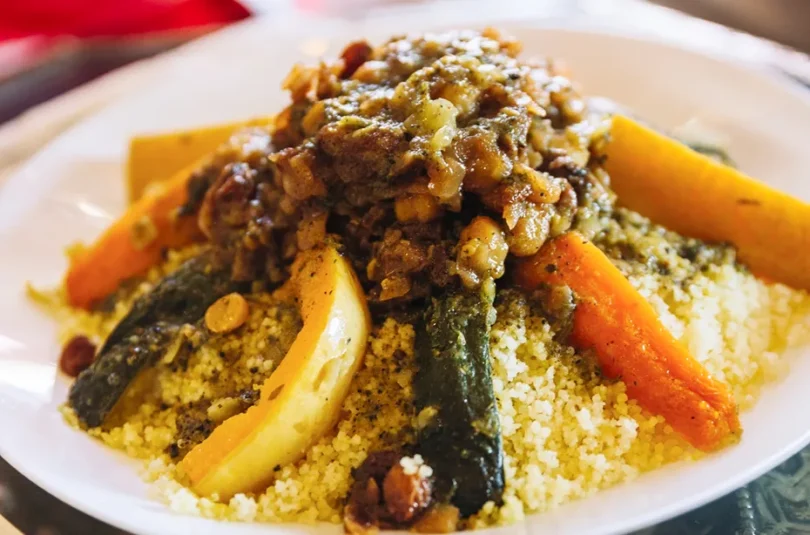Introduction – Order in Taste
In Morocco, design is not limited to what is seen or built. It exists in the way flavor is constructed. The same discipline that shapes courtyards and mosaics also organizes the kitchen. Geometry is not decoration; it is a method of thought.
From the layered logic of a tagine to the calibrated sweetness of an almond pastry, Moroccan cuisine reveals an invisible blueprint of proportion and rhythm. Every dish is designed with purpose, built from a foundation, and balanced by structure. The plate becomes an edible plan, where flavor follows form.
Proportion as a Culinary Principle
Architecture in Morocco has always been guided by proportion. The courtyard aligns to the sky, the fountain to the walls, the patterns to one another. The same reasoning shapes Moroccan cooking. A dish succeeds when its elements coexist in measured harmony.
Sweetness, acidity, and spice are never accidental. Each exists in a specific ratio that defines identity. In a lamb tagine with prunes, the fruit’s sugar lifts the salt of the meat, while saffron and ginger act as supporting columns. When the ratios shift, the dish loses its stability, much like a structure that ignores balance.
This sense of proportion is not taught through theory. It is inherited through repetition, passed from hand to hand, refined over centuries until instinct becomes geometry.
Layers and Foundations
Traditional Moroccan cooking is built like architecture. The tagine forms its foundation through slow layering, base, middle, and top. The steam cycle inside its cone resembles the logic of vaulted ceilings, where energy moves in rhythm between weight and release.
Couscous follows the same structural clarity. Each grain is steamed repeatedly, lifted and aerated until it achieves architectural lightness. The sauce, poured at the end, connects every level of the dish, like a courtyard fountain linking different wings of a home.
This structural thinking predates fine dining. It shows that Moroccan cuisine has always been organized through design, even when expressed in humble kitchens.
Rhythm and Repetition
Geometry in Moroccan design relies on rhythm, the repetition of tiles, arches, and calligraphic lines. The same repetition appears in the act of cooking. The rhythm of grinding spices, folding pastry, or layering ingredients produces more than flavor. It generates order.
Each motion contributes to a final pattern that is not visible but felt. When couscous grains fall evenly, when sauce distributes without flooding, when spice infuses but does not dominate, rhythm becomes the invisible structure that defines refinement.
The Structural Role of Ingredients
Ingredients in Moroccan cuisine behave like materials in architecture. Each has a specific strength and purpose. Spices create vertical lift, herbs give horizontal spread, citrus defines edges, and oil binds surfaces.
This approach treats food not as improvisation but as construction. The cook assembles weight, line, and color with the same logic as a builder reading a plan. A completed dish must stand on its own, coherent in both taste and proportion.
Modern Moroccan gastronomy continues this practice with new precision. Instead of walls and domes, it builds balance and contrast on a smaller scale, translating architectural discipline into flavor architecture.
Spatial Thinking on the Plate
In contemporary fine dining, Moroccan chefs apply the same awareness of space found in traditional design. Instead of filling the plate, they shape emptiness around the food. This controlled distribution resembles the measured spacing of a riad courtyard or a minaret’s repeating arches.
The composition invites the eye to travel, to rest, to return, the same way a visitor moves through structured space. Taste follows that path. Each bite becomes a step in an architectural journey where proportions dictate emotion without words.
Continuity and Logic
What connects Moroccan architecture and cuisine is not appearance, but thought. Both are systems built on measured relationships. A wall must carry light the way a sauce must carry spice. A pattern must repeat with reason the way flavors must repeat with intention.
This logic of making, practical, precise, and cultural, defines Moroccan refinement. It shows that elegance is not an aesthetic choice but a structural outcome of order and clarity.
Conclusion – The Architecture of Taste
To taste Moroccan cuisine is to read its geometry. Every flavor has placement, every texture has purpose. Proportion replaces ornament as the true expression of beauty.
Architecture and gastronomy in Morocco share the same vocabulary of discipline and grace. One is built of stone, the other of spice. Both remind us that structure is not the opposite of creativity. It is its foundation.


Leave a Reply